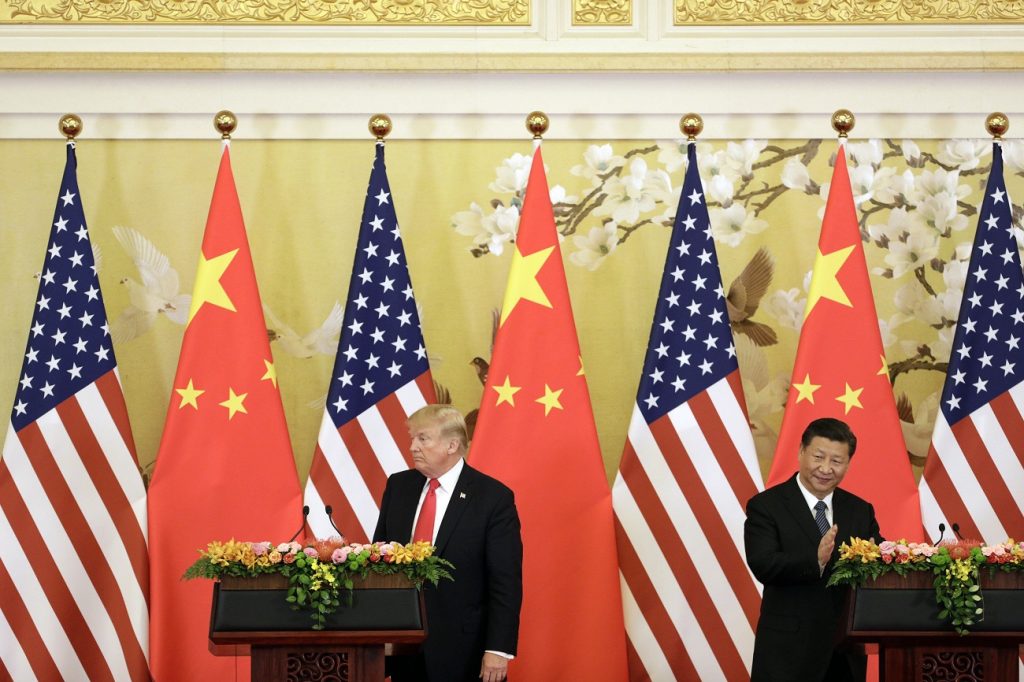When Donald Trump first announced the steel tariffs in early March, capital rejected it almost in unison. The Business Roundtable publicly opposed them, along with virtually all major industries (except steel, of course), including retail, auto, aircrafts, beer, and construction, immediately voiced their opposition. Even Charles Koch blasted Trump over the issue. Not only would any retaliatory action by the EU and other steel producers have been very harmful for the U.S. economy, the steel tariffs themselves would, according to a report by Econofact, have put at risk far more jobs than they could help keep because such tariffs would raise the input costs for other production lines and thus make the companies producing those goods less competitive.
After three weeks of uncertainty, Trump changed gears and aimed all (trade) weapons at one single foe: China. In the same act, he poked so many holes in the net of steel tariffs that almost any country selling steel to the U.S. got a free pass, including the EU. China almost immediately threatened with retaliatory taxes on American products for $3 billion (only a fraction of the $60 billion worth of tariffs on Chinese goods). The New York Times complained the following day that Trump was making the World Trade Organization irrelevant, while almost all mainstream newspapers and economists from a wide spectrum continued warning against what now seems like a catastrophic scenario: a trade war.
Nationalists on the Rise
There has been a marked rebirth of nationalist movements in the advanced capitalist countries. The far right has made substantial gains in the polls across Europe, from the Alternative for Germany (AfD) to the National Front in France, to the League in Italy. Donald Trump’s victory owes much to a nationalist sentiment – epitomized in the “MAGA” slogan – and to a rejection of the global order as it is today (“unfair”). The Brexit victory is another example of nationalist rhetoric winning in the polls.
However, capital is today more “global” than ever, and a protectionist escalation would hurt capitalists the most. The transnationalization of capital does not mean that nation-states are obsolete or withering away. In fact, it is these nation-states that create and maintain the legal and social fabric on which capital thrives. However, it is largely thanks to cheap labor in Bangladesh that American apparel firms can compete in the global market and make profits; the same goes for transnational companies in other production lines. This is why the U.S. bourgeoisie was horrified at the prospect of tariffs on steel and aluminum.
Transnational production processes have knit national economies of different countries to one another like never before. Global value chains have knit regions together in a transnational traffic of intermediary goods that travel across many borders before they are assembled in the final product. This process, spread out across many different countries, is made possible on the basis of a smooth transit of commodities in a “free-trade”, globalized market. While it is true that there have always been restrictions on, and negotiations around, import taxes, and, furthermore, free trade agreements and the curbing of exchange barriers have been repeatedly used to benefit big capital, the tendency has been towards more permeability. The introduction of friction (restrictions, taxes) in the mobility of goods can have disastrous consequences for this industrial network, including the assets accumulated abroad.
Importantly, then, there is a tension (or a fragile equilibrium) between the economic interests of capital (in the U.S. and in other central countries) on the one hand and the pressure on governments by popular revolts against neoliberalism or globalization on the other. In fact, when people express discontent about globalization, what they are usually rejecting is the economic changes brought about by neoliberalism: decreasing real wages, job insecurity, the rolling back of job-related benefits, and the retreat of the welfare state. (A discussion on the complex relation between neoliberalism and globalization is beyond the scope of this article,) Right-wing populism has tied these economic realities to narratives about an alleged flood of both foreign workers and foreign goods across national borders, and to the loss of jobs due to offshoring. The anti-establishment sentiment in the U.S. found expression in 2016 in the unprecedented popularity of Bernie Sanders and Donald Trump, as well as the lackluster performance of Wall Street and K Street’s favorite: Hillary Clinton.
Trump used an economic-nationalist rhetoric as a springboard into office. However, during his first year in office he failed to deliver. The departure of Gary Cohn, one of the last “globalists” in the White House, and the appointment of die-hard hawks such as John Bolton signal a more aggressive presidency for the second year. Against the background of a deep crisis of legitimacy that affects both American traditional parties and the neoliberal project in general, Trump is poised to do the unexpected. However, he will have to overcome immense structural resistance.
Stop Capital Flight
The centerpiece of the nationalist discourse is the complaint about jobs taken abroad. Capitalist relocation has left decaying, post-industrial landscapes in traditionally blue-collar strongholds like Detroit, MI, Pittsburgh, PA, and Youngstown, OH, among many other cities in what more than 30 years ago was appropriately dubbed the rust belt.
Rivers of ink have been spilled on the subject of capital’s mobility and the process of de-industrialization that has been taking place in the central countries. To a large extent, this makes sense since there are virtually no geographical limits to where capital can go today. In the face of increased global competition, as well as rising labor costs and sometimes a more organized and militant workforce in advanced countries, capital resorts to what David Harvey called the spatial fix (relocation) to maintain or restore profitability.
In many ways, there is today a relatively globalized labor market, where the workforce in Vietnam competes with that of Mexico and the Philippines. This, in turn, has served everywhere as a bargaining asset on the side of capital: “If you don’t accept this cutback on wages, I will have to shut down and move production to Taiwan.” It is a game that unions have largely accepted. Thus, we’ve seen the Steelworkers’ Union cheerleading Trump’s steel tariffs. The tariffs are supposed to make investment in U.S. territory more profitable and thus bring back jobs lost to offshoring.
So capital in the manufacturing sector seems to be extremely mobile today. But it would be a mistake to believe that there is no limit to its mobility. After all, moving capital can be expensive and sometimes not worth the cost. Once a company makes an investment in a state-of-the-art facility in, let’s say, the outskirts of Chicago, capital’s own rules dictate that for the following years it has to produce as much as possible to recover the investment and start making profits. In addition, the transportation of final goods to their destination market increases with the distance, narrowing down the options for profitable relocations. In other words, the idea that capital can move anytime and anywhere is misleading.
Who stole my job?
Some scholars have challenged the narrative that deindustrialization is caused primarily or single-handedly by offshoring. In Global Restructuring and the Power of Labour, Bill Dunn builds on solid empirical evidence to contend that the vast majority of direct investment remains within industrialized countries and that the relocation of industries for export back to central countries is still minor. In the auto industry, for example, most low-income countries only produce for their internal market, South Korea (no longer a low-income country) being the only exception. The case of Mexico, another outlier, is paradigmatic of a pattern in capital relocation, which is the building of assembly facilities in proximity to the final market – in this case, the U.S. Dunn’s conclusion is that capital may go, but not too far.
From a similar point of view, Kim Moody argues in On New Terrain, that the increase in productivity has been the major force driving people out of the workforce. Although the advances in technology have been important in this regard, he emphasizes the role of lean production. Originating in Japan in the early 1980s, lean production has set a standard, spreading across the globe in the span of a few years. It can be described as a set of techniques aimed at the elimination of waste (of time and material) and at making the labor process more efficient – at the expense of workers by way of shorter breaks, longer shifts, rotating schedules, etc. Kim Moody argues that these changes, along with technological innovation, have been responsible for most of the reduction in employment in the U.S. in the past four decades.
A complete account, however, needs to include a consideration of both forces at play – offshoring and the increase in productivity. The technology sector in the U.S. is probably a paradigm case of the shift of new industries and jobs to overseas locations. The most prominent example of this trend is the Chinese-based FoxConn, which produces electronics for Apple, Samsung, Toshiba, Dell, Microsoft, and Nokia, among others, and was reported to account for half of the global electronics production in 2012. With half a million people working at FoxConn’s largest facility in Shenzhen, the company reportedly holds over 30 factories in mainland China and has sprawled operations to a dozen countries, including in Eastern Europe, the Middle East, India, Japan and South America.
However, it is the final seller (Apple, Samsung, Nokia) that gets the lion’s share of the surplus value created. A 2013 report by the Unctad showed that 67 percent of the total value added in global value chains is captured by firms based in rich nations. This means that although China is producing the goods, it’s American, European, and Japanese firms that reap the bulk of the profits. Furthermore, it is thanks to the low labor costs provided by China that these companies are able to stay competitive. But this is only part of the story.
Massive capital investment has allowed the Chinese economy to grow at an unprecedented rate for decades and achieve a GDP per capita of a middle-income country. Its investments overseas have proliferated exponentially, feeding China’s aspirations of becoming world hegemon. A breakneck economic development, built on the backs of near-slavery laboring conditions, has brought about the emergence of a generation of billionaire business owners and skyrocketing inequalities.
China’s ambitions in the race for global hegemony hinge upon its ability to shift from an export-oriented economy to one with a higher productivity, higher-income workforce, and an internal market for its goods. However, the competition for global hegemony will not be a peaceful one. A central piece in the race is what the Economist suggestively called the battle for digital supremacy: the accumulation of cutting-edge technology in production through acquisition of foreign firms, government subsidies, and investment in China and abroad, in order to become world leader in economic, political and military terms.
A Test for U.S. Hegemony
The Trump administration moved away from (steel and aluminum) tariffs across the board to import taxes targeted exclusively at China. This shift is not minor. The EU is no longer bracing itself for a trade war with the U.S., and vast sectors of the U.S. economy that are heavily dependent on foreign markets have found some respite. The prospects of a multilateral protectionist escalation look less likely now – although they are far from over. For now, all guns are pointing at China.
The risks, however, are considerable. China announced retaliatory tariffs on 128 American products worth 3 billion dollars (only 5 percent of the expected cost imposed by U.S. tariffs), but it is likely that Beijing will decide to raise them if Washington does not back down or soften restrictions. The situation can still get out of hand.
The announced tariffs are justified on the grounds of the alleged theft of intellectual property and other unfair practices by the Chinese government to consolidate its position as technology producer – a much more credible case to defend before the World Trade Organization (WTO) than the argument that steel tariffs are motivated by national security interests. The business community in the U.S. has been quiet, with some off-the-record approving remarks. The crusade against Chinese electronics can unite a broad sector of capital, middle-class nationalists, and some working-class people caught up in manufacturing nostalgia. However, there will be opposition from manufacturers who use Chinese electronics as input for their products. In addition, customers will have to pay higher prices for any goods coming from China.
The WTO incorporated China in 2001 with the expectation that the Asian giant would be compelled to open the economy to foreign products and curb state intervention. After 17 years, China remains insufficiently open as far as U.S. business is concerned, which yearns for its domestic market. Meanwhile, the U.S. government is also concerned about its annual trade deficit of $375 billion. In addition, China has required tech companies who want to invest in the country to share intellectual property assets and knowledge on innovation and technology development. This has ostensibly given Chinese tech companies an advantage over foreign competitors in the global market.
Ultimately, the success of Trump’s tariff strategy will depend on his administration’s ability to exert pressure on U.S.-allied countries to follow suit. That is, it is a test for U.S. hegemony. If other countries join, China will have to cave to U.S. demands of further opening its internal market and curb its own demands on foreign technology companies. If the measures elicit a bilateral tit-for-tat between China and the U.S., the rest of the economies will benefit from lower costs of production and open access to foreign markets to sell their goods, and therefore American firms will be in disadvantage. The weight of China in the global economy makes this scenario far from certain. Trump’s move against China can be interpreted as a forceful attempt to open the Chinese internal market to American goods and simultaneously as a test for U.S. hegemony at a time when its leadership is undoubtedly in decline.











